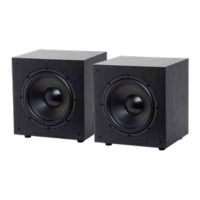9
SUBV10 & 12 Manual
Connecting your Subwoofer with Speaker Wires is the least common method. If
you’re equipment lacks both dedicated Subwoofer Outputs and Line Outputs,
you can use your receiver or amplifier’s Speaker Outputs. For EACH Le and Right
main Speaker Output, run one pair of + and – speaker wires from the component’s
Speaker Outputs to the RED (+) and Black (-) High Level Inputs marked “HIGH IN”
on your subwoofer. Verify that both wires are connected with the correct polarity,
i.e. Positive (+) to Positive (+) and Negative (-) to Negative (-). Then, run a pair of
speaker wires from your subwoofer’s RED (+) and Black (-) High Level Outputs to
your front le and right speakers, again verifying correct polarity. Connecting your
subwoofer and speakers this way ensures each speaker gets the correct output
signals from your receiver or amplifier.
Note:
Since your subwoofer operates in mono, it does not require a Le and Right
designation for the High Level inputs. However, it is critical that the orientation
remain consistent through the High Level outputs—i.e., use the top set of inputs
and outputs for the le channel signals, or vice versa.
Speaker Wire Audio Connection
amplifier, or other component lacking a subwoofer or LFE output, you can use the
Le and Right Variable Line Outputs, if available. (Note: Using a Fixed line output
is not recommended, since your subwoofer will stay at a “fixed” volume level
regardless of your system’s main volume setting). Run a stereo, RCA-terminated
subwoofer cable from the component’s Le and Right Variable Line Output jacks
to the line input jacks labeled LINE IN on the subwoofer’s back panel.

